|
from various Websites
The Orion
Mystery
The three pyramids of Giza are a perfect reproduction
of the 3 stars of Orionís belt:
-
 Like
the pyramids, the three stars of Orion are not perfectly
aligned, the smallest of them is slightly offset to the East. Like
the pyramids, the three stars of Orion are not perfectly
aligned, the smallest of them is slightly offset to the East.
-
All three are slanted in a
Southwesterly direction (Note the exact match in the animation).
-
Their orientation to the Nile
recreates Orionís orientation to the Milky Way.
-
The layout of the pyramids, and
their relative sizes were a deliberate design plan, and not the
result of three kingís enormous egos as been preached as dogma
by the so-called Egyptologists.
Robert Bauval has spent the last
ten years investigating the pyramids themselves and the Pyramid
Texts, the oldest writings known to mankind. He and Adrian
Gilbert have uncovered for the first time the key to the plan
that governed the construction of the pyramids. They reveal in "The
Orion Mystery" that the pyramids were much more than just tombs:
they were nothing less than a replica of Heaven on Earth (The
constellation of Orion, or known to the Egyptians as
Osiris). With great astronomical precision, the pyramids
were created to serve as the pharaohís gateway to the stars.
Return
The
Giza/Orion Link
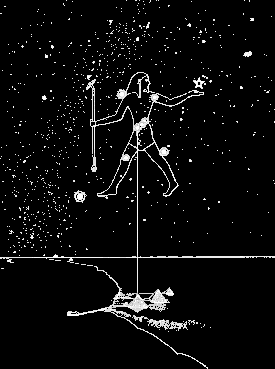 The
Giza Plateau in the year 10,450 BC.
This is a depiction of how the Sphinx and the
three Pyramids at Giza would align with Orionís Belt in the
year 10,450 BC. (image left) The
Giza Plateau in the year 10,450 BC.
This is a depiction of how the Sphinx and the
three Pyramids at Giza would align with Orionís Belt in the
year 10,450 BC. (image left)
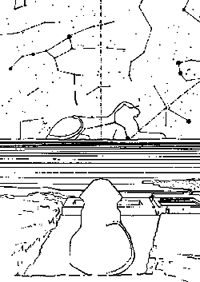 The three Pyramids exactly simulate the stars Delta Orionis [Mintaka],
Epsilon [Alnilam], and Zeta [Alnitak]
that comprise the Orion Belt. The three Pyramids exactly simulate the stars Delta Orionis [Mintaka],
Epsilon [Alnilam], and Zeta [Alnitak]
that comprise the Orion Belt.
During this era, the Age of Leo, The Sphinx, which
originally may have fully resembled a lion, would have been looking
directly due east at itís celestial counterpart as it rose at dawn
of the vernal equinox in 10,450 BC.
At the same time, the Nile would have corresponded with the
Milky Way.
Other constructions in Egypt mirror key components of the Orion
Constellation.
Return
Introduction to The Orion Mystery
Over the past 200 years great advances
have been made in our understanding of ancient Egyptian culture.
From knowing virtually nothing we have now reached a stage where we
are able to translate directly from hieroglyphs.
But many mysteries remain largely unsolved:
-
Why did the Egyptians build the
pyramids?
-
How did they achieve such
amazing feats of architecture and engineering?
-
When exactly were they built?
For many years classical Egyptologists
maintained that the Pyramids were merely grandiose tombs to
commemorate dead Pharaohs, built by slave labour and laid out in a
relatively unstructured manner. However, recent work by Robert
Bauval has shed an intriguing new light on the issue.
He realized that the relative sizes, and detailed positioning of,
the Giza pyramids were a faithful mimicry of the stars
forming the íbeltí in the constellation of Orion. In
addition, it transpired that the supposed íair shaftsí in the
pyramids actually pointed directly towards Orion,
apparently with the aim of projecting the soul of the deceased king
out towards the constellation.
These discoveries alone re-wrote our understanding of the
motivations for building the pyramids and the state of technological
advance of the ancient culture. But the plot continues to thicken
with a robotic camera sent into the shafts recently enabling
the discovery of a door to a previously unknown secret chamber deep
within the structure. Rumours abound that imminent discoveries may
even more radically change our perception of ancient civilization...
Return
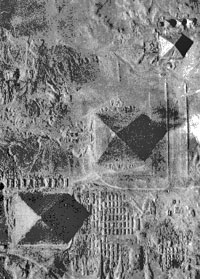 The
correlation between the Giza Pyramids and Orionís belt The
correlation between the Giza Pyramids and Orionís belt
This is an aerial picture of the Memphite Necropolis Site at Giza,
south-west of Cairo. Look carefully at the way the Pyramids are
aligned.
At first glance they seem to be imperfectly positioned.
Classical Egyptologists maintain that this was either a mistake or a
result of the terrain in the Giza Plateau.
Compare this to the image
of the Belt Stars of Orion and things become a little clearer.
Far
from being a mistake, the Pyramids are aligned almost exactly as the
Belt Stars appear!
Go
Back
Egyptology
and Egyptologists
Great advances have been made in the study of the Ancient Egyptian
Civilization in the last two hundred years. In that time we have
gone from having virtually no knowledge whatsoever, to being able to
translate directly from the hieroglyphs on the walls of pyramids and
temples with a high degree of accuracy. This giant leap forward in
knowledge was thanks to a very fortunate find by a group of Napoleon
Bonaparteís soldiers as they secured Egypt for the French in 1798
and 1799.
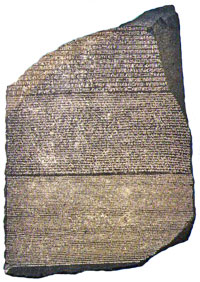 During the late 18th and early 19th centuries
Rashid (the town known
in the West as Rosetta) was an important port, lying at the mouth of
the Nile, where the Rashid Tributary leaves for the Mediterranean
Sea. Napoleon knew well its significance in securing a port for the
supply of his troops as they swept across Egypt and fought hard to
win control. Napoleon was a superb tactician -- he had no real
desire to wrest Egypt from the Mamluk Turks for commercial reasons.
He had only one intention as he pushed the Turks East, and that was
to cut off the supply and trade route for the British to India. During the late 18th and early 19th centuries
Rashid (the town known
in the West as Rosetta) was an important port, lying at the mouth of
the Nile, where the Rashid Tributary leaves for the Mediterranean
Sea. Napoleon knew well its significance in securing a port for the
supply of his troops as they swept across Egypt and fought hard to
win control. Napoleon was a superb tactician -- he had no real
desire to wrest Egypt from the Mamluk Turks for commercial reasons.
He had only one intention as he pushed the Turks East, and that was
to cut off the supply and trade route for the British to India.
A party of French troops found a black basalt slab, near to the town
of Rashid in 1799, inscribed in three languages. The slab was a
tribute to the Egyptian King Ptolemy V, with the original
hieroglyph, a more modern demotic script, and, the key to our
knowledge of Ancient Egypt today, a Greek translation alongside
carved in 196 BCE. The French returned control of Egypt to the
English, and the Rosetta Stone
(click image left to enlarge), as it had become known, was taken to
London, where it can still be seen as a prize exhibit in the British
Museum, in Bloomsbury.
On arriving in London, the Stone was studied intently by Thomas
Young, a West-country doctor and Egyptologist. Young had studied at
London, Edinburgh, Gottingen and Cambridge, qualifying as a
physician in 1800. From 1801 to 1803, Young was Professor of Natural
Philosophy at the Royal Institution, and it was here that much of
his pioneering work on deciphering the Stone was done. Between 1822
and 1824, the French Egyptologist Jean Francois Champollion took up
a close study of the Stone, and founded modern scientific
Egyptology.
These preliminary studies of the Stone allowed Egyptologists their
first insight into the mind of the Ancient Egyptians. Things that
were once hidden and meaningless began to become apparent, and this
small seed of new knowledge soon allowed much more accurate
translations of the previously attractive but ill understood
hieroglyphics that adorned the walls of pyramids and tombs and
temples all over Egypt. Many of the old theories were overturned and
replaced by conclusions arrived at by scientific research.
Foremost among the "classical" Egyptologists is the late
E. A.
Wallis Budge, 1857-1934. Budge was Keeper of Egyptian and Assyrian
Antiquities at the British Museum, and author of many books that
form the basis of our understanding of Ancient Egypt. In particular
he is remembered for his work in translating the Book of the Dead,
and several hieroglyphic dictionaries, and self-teaching courses.
Budge also translated numerous texts directly from the walls of
later Fourth and Fifth Dynasty tombs, and cast an unbiased eye over
many of the myths of the Egyptian deities and their legends.
 Much good work has been done over the last couple of centuries
towards understanding something of Ancient Egyptian culture. Some of
the most impressive work done in recent years, however, has to be
the study of the astronomical significance of the pyramids by
Robert Bauval and Adrian Gilbert. They published their
preliminary findings in the excellent book "The Orion Mystery"
(click image right) published by Heinemann. They also made a documentary
TV programme last year that first drew them to the worldís
attention. Much good work has been done over the last couple of centuries
towards understanding something of Ancient Egyptian culture. Some of
the most impressive work done in recent years, however, has to be
the study of the astronomical significance of the pyramids by
Robert Bauval and Adrian Gilbert. They published their
preliminary findings in the excellent book "The Orion Mystery"
(click image right) published by Heinemann. They also made a documentary
TV programme last year that first drew them to the worldís
attention.
The views expressed in the book and documentaries were initially
scorned by the academic mainstream Egyptologists. However, as the
evidence strengthens their case, more and more people are coming on
board and the "old school" are looking increasingly isolated.
Go
Back
The
Importance of Astronomy
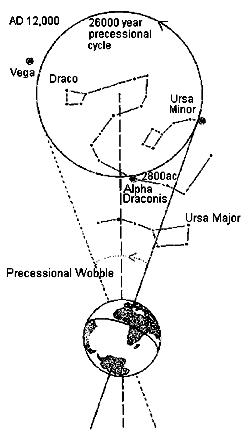 Astronomy is fundamental to Bauvalís Correlation Theory.
Over a cycle of 26 000 years the Earth wobbles slightly on its axis
and this leads to an apparent change in the position of the stars.
This phenomenon is known as Precession -- the stars precess one
another in Declination, their relative position in the sky. This is
best described with the aid of the adjacent diagram
(image right). Astronomy is fundamental to Bauvalís Correlation Theory.
Over a cycle of 26 000 years the Earth wobbles slightly on its axis
and this leads to an apparent change in the position of the stars.
This phenomenon is known as Precession -- the stars precess one
another in Declination, their relative position in the sky. This is
best described with the aid of the adjacent diagram
(image right).
As the Earth wobbles the Pole Star that marks the approximate
Celestial Pole changes. Polaris marks the spot now,
but at the time of the Pyramids it was marked by
Thuban
in the constellation of Draconis. In 12 000 AD
Vega in the constellation of Lyra will mark
the Pole.
A further change in the starsí actual position is caused by the
expanding Universe. Stars are not stationary in space -- they have
what is termed Proper Motion. Some stars are moving towards
Earth while others are moving away. Groups of related stars like the
Belt Stars of Orion tend to move together through
space.
The rate of change of a starís position from the observerís location
is a function, among other things, of its distance. Stars that are
very distant appear to move more slowly. This is the case with the
Belt Stars which lie approximately 1400 light years from
Earth. Thus, over the centuries, they have changed in Declination
dramatically, causing them to rise and set at widely differing
times. They retain their characteristic shape, however, because of
their distance.
It is vitally important to understand that the sky looked different
at the time of the Pyramids. The overall shape of the
Belt Stars has remained remarkably similar although
many other parts of the sky have changed dramatically. Thanks to
sophisticated computer software it is possible to project the sky
back in time, enabling Bauval to verify and build upon his
theory.
Go
Back
The
Egyptian Star Religion
Classical Egyptologists believe that the Egyptians practiced a solar
religion, centering on the worship of Ra. This
cult of Ra, centered around Heliopolis,
the City of the Sun, was no doubt important, but it seems as
though it was an offshoot of a much more ancient stellar religion.
All the evidence that is now coming to light suggests that Ra
was merely one of the instruments by which the King returned to the
First Time, rather than his goal.
"O Shining One (Ra)! O Shining One!
O Khepera! O Khepera! You are for the King and the King is for
you; you live for the King and the King lives for you."
(Pyramid Texts Utterance 662)
"Go aboard this boat of Ra to which
the gods desire to draw near, aboard which the gods desire to
go, in which Ra rows to the horizon....... Raise yourself, O my
father Osiris the King, for you are alive!"
(Pyramid Texts Utterance 667)
The application of astronomy to the
study of Ancient Egypt shows that the stars were of the
utmost importance as the destination of the King:
"O Great One of Atum (another
attribute of Khepera, the creator), son of a great one of Atum,
the King is a Star in the sky among the gods."
(Pyramid Texts Utterance 586A)
"O King, you are this great star, the companion of Orion, who
traverses the sky with Orion, who navigates the Duat with Osiris;
you ascend from the East of the sky, being renewed at your due
season......."
(Pyramid Texts Utterance 466)
The King was very important because he
was the link between the gods and men, and was accorded enormous
respect in life and in death. From the moment of his birth he was
groomed and trained for his return to the First Time. All his
life, every aspect of it, was associated with his journey. He was
taught spells and incantations to secure a safe passage, many of
which are collected in the Book of the Dead and the
Pyramid Texts.
His sole aim in life was his successful return to the First Time,
and the pyramids, far from being a memorial or commemorative tomb,
were the starting point of this greatest of journeys. The geometry
of the pyramids has been a source of confusion for many years, as
was the seemingly imperfect way in which they were laid out on the
Necropolis site.
The chain of command in Egypt was unbroken -- each King, though a
living, breathing being, was a renewal of the covenant which
the gods made with man. The dead King, though dead to this
world, lived on in spirit as he made his way back to the beginning,
to the First Time. His son, the new Horus King, took
over his place as surely as the dead King has taken his own, and
ensured the continuation of the Great House, the Pr Aa.
Go
Back
Ancient
Egyptian Culture and Society
Although we look these days at everything in isolation, for the
Ancient Egyptians this would have been unthinkable. What we now term
as a holistic approach to life was normal for the Egyptians.
In fact, the holistic approach was very common in our own Western
culture until the Industrial Revolution. At the end of the
Eighteenth Century, life became fragmented into production and
consumption, supply and demand. Many people whose life was on the
land, and who were intimately acquainted with every aspect of life
as a cohesive and living whole (hence holistic) were made redundant
by the new machines.
The only work, and life, available to them meant going from the land
to the towns and cities. Instead of producing to meet their own
needs, and then either bartering or selling their surplus from a
good yearís harvest, they were forced into wage slavery -- to total
dependence upon those who controlled the means of production.
In Ancient Egyptian times there was no wage slavery, rather a
communal approach to life, and a very stable society. Everyone had
their place, their tasks, and co-operated with others to ensure
survival, peace and prosperity. The Biblical notion of enforced
slavery to the Pharaohs seems to be exaggerated, testified by
the meteoric rise in status of the Prophet Yusuf (Joseph)
and his clan.
Knowledge of the logistics of building a pyramid like those at the
Memphite Necropolis at Giza put paid to the idea that they
were built by ill-treated slave labour. The craftsmanship is of the
highest degree -- it is still a mystery to this day how the pyramids
were built.
Go
Back
About
Robert Bauval
The pyramids have long fascinated Robert Bauval. He is
Egyptian, born in Al-Iskandariyya (Alexandria)
to Belgian parents, and has spent most of his life living and
working in the Middle East. For many years he had pondered over the
significance of Sah, the constellation of Orion,
and its link to the pyramids. One night, while working in Saudi
Arabia, he took his family and a friendís family up into the sand
dunes of the Arabian desert for a camping expedition.
Bauval knew that the seemingly inconsistent layout of the
three Fourth Dynasty pyramids at Giza was no accident, and had
applied his own engineerís mind, and those of many friends to the
problem. Most agreed that the alignment, though unusual, was
no accident, given the precise mathematical knowledge that
the Egyptians had.
His friend, a keen amateur astronomer, pointed out Orion,
and mentioned, in passing, that Mintaka, the smaller
more easterly of the stars making up Orionís belt was offset
slightly from the others. Immediately Bauval saw the answer
-- the three Belt Stars were aligned in exactly the same way as
the three pyramids!
Bauval checked the alignment in 2450 BCE by precessing the
three Belt Stars back, and found that, due to their close
proximity in space, great distance from Earth, and negligible proper
motion, they looked exactly the same then as they do today. Of
course, they had changed in declination -- then they were just below
the celestial equator, at about -1 degree declination.
The pyramids were a mirror image, the Earthly representation
of the Belt of Orion, the destination of the dead King! The
Egyptians were dualists -- everything they thought and believed was
a duality. Everything had its counterpart, cause and effect, left
and right, East and West, death and rebirth -- nothing was ever seen
in isolation. They had constructed at Giza an exact replica of
the Duat destination of the King. Far from being a tomb,
the pyramid was the starting point of the Kingís journey back to
the stars from whence he came, back to the First Time.
Bauval initially made use of the astronomy program
Skyglobe 3,5 for the PC. Though too inaccurate for serious work
-- it does not take proper motion, nutation, refraction, for
example, into account -- it was sufficient to clarify Bauvalís
mind as to the value of his discovery. Skyglobe 3,5 will plot
the Milky Way on its charts if requested, and doing so added
further proof to Bauvalís theory. Giza is West of the Nile
-- putting the plane of our galaxy into the equation showed that
Orion is "West" of the Milky Way, in proportion to
Giza and the Nile.
Go Back
|
 Like
the pyramids, the three stars of Orion are not perfectly
aligned, the smallest of them is slightly offset to the East.
Like
the pyramids, the three stars of Orion are not perfectly
aligned, the smallest of them is slightly offset to the East.
 The
Giza Plateau in the year 10,450 BC.
This is a depiction of how the Sphinx and the
three Pyramids at Giza would align with Orionís Belt in the
year 10,450 BC. (image left)
The
Giza Plateau in the year 10,450 BC.
This is a depiction of how the Sphinx and the
three Pyramids at Giza would align with Orionís Belt in the
year 10,450 BC. (image left) The three Pyramids exactly simulate the stars Delta Orionis [Mintaka],
Epsilon [Alnilam], and Zeta [Alnitak]
that comprise the Orion Belt.
The three Pyramids exactly simulate the stars Delta Orionis [Mintaka],
Epsilon [Alnilam], and Zeta [Alnitak]
that comprise the Orion Belt. 


 Astronomy is fundamental to Bauvalís Correlation Theory.
Over a cycle of 26 000 years the Earth wobbles slightly on its axis
and this leads to an apparent change in the position of the stars.
This phenomenon is known as Precession -- the stars precess one
another in Declination, their relative position in the sky. This is
best described with the aid of the adjacent diagram
(image right).
Astronomy is fundamental to Bauvalís Correlation Theory.
Over a cycle of 26 000 years the Earth wobbles slightly on its axis
and this leads to an apparent change in the position of the stars.
This phenomenon is known as Precession -- the stars precess one
another in Declination, their relative position in the sky. This is
best described with the aid of the adjacent diagram
(image right).